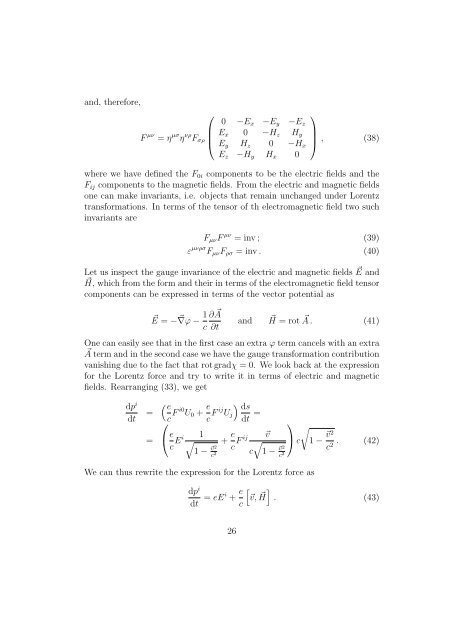Topics in Classical Electrodynamics
Topics in Classical Electrodynamics
Topics in Classical Electrodynamics
Create successful ePaper yourself
Turn your PDF publications into a flip-book with our unique Google optimized e-Paper software.
and, therefore,<br />
⎛<br />
F µν = η µσ η νρ F σρ<br />
⎜<br />
⎝<br />
0 −E x −E y −E z<br />
E x 0 −H z H y<br />
E y H z 0 −H x<br />
E z −H y H x 0<br />
⎞<br />
⎟<br />
⎠ , (38)<br />
where we have def<strong>in</strong>ed the F 0i components to be the electric fields and the<br />
F ij components to the magnetic fields. From the electric and magnetic fields<br />
one can make <strong>in</strong>variants, i.e. objects that rema<strong>in</strong> unchanged under Lorentz<br />
transformations. In terms of the tensor of th electromagnetic field two such<br />
<strong>in</strong>variants are<br />
F µν F µν = <strong>in</strong>v ; (39)<br />
ε µνρσ F µν F ρσ = <strong>in</strong>v . (40)<br />
Let us <strong>in</strong>spect the gauge <strong>in</strong>variance of the electric and magnetic fields ⃗ E and<br />
⃗H, which from the form and their <strong>in</strong> terms of the electromagnetic field tensor<br />
components can be expressed <strong>in</strong> terms of the vector potential as<br />
⃗E = − ⃗ ∇ϕ − 1 c<br />
∂ ⃗ A<br />
∂t<br />
and ⃗ H = rot ⃗ A . (41)<br />
One can easily see that <strong>in</strong> the first case an extra ϕ term cancels with an extra<br />
⃗A term and <strong>in</strong> the second case we have the gauge transformation contribution<br />
vanish<strong>in</strong>g due to the fact that rot gradχ = 0. We look back at the expression<br />
for the Lorentz force and try to write it <strong>in</strong> terms of electric and magnetic<br />
fields. Rearrang<strong>in</strong>g (33), we get<br />
dp i<br />
dt<br />
=<br />
=<br />
( e<br />
c F i0 U 0 + e ) ds<br />
c F ij U j<br />
dt =<br />
⎛<br />
⎞<br />
⎝ e 1<br />
c Ei √ + e √<br />
1 −<br />
c F ij ⃗v<br />
√ ⎠ c 1 − ⃗v2<br />
⃗v2 c 1 −<br />
c . (42)<br />
2 ⃗v2<br />
c 2 c 2<br />
We can thus rewrite the expression for the Lorentz force as<br />
dp i<br />
dt = eEi + e [<br />
⃗v, H<br />
c<br />
⃗ ]<br />
. (43)<br />
26
















